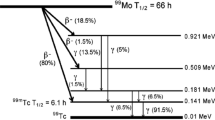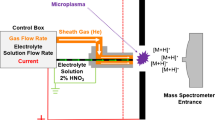Abstract
Reference information on isotopic composition of various uranium materials, determined with high accuracy and precision, is of essential value for nuclear safeguards and nuclear forensics. In addition, an accurate knowledge of the isotopic composition is important when isotope-specific measurement techniques such as inductively-coupled plasma mass spectrometry (ICP-MS) are employed for elemental analysis. Isotopic composition of ten uranium chemicals and standards for elemental analysis, acquired from various commercial suppliers, was measured using thermal ionisation mass spectrometry in the modified total evaporation mode. Two of the chemicals analyzed are based on either natural uranium (NU) or ‘commercial NU’. The majority of the materials were found to contain uranium substantially depleted in 234U and 235U, with presence of 236U significantly above the range observed for NU. Model scenarios are suggested for a combination of uranium irradiation and enrichment processes which may have resulted in such compositions.





Similar content being viewed by others
Notes
WIMS stands for Winfrith improved multigroup reactor [code] scheme. Winfrith Atomic Energy Establishment was a UK Atomic Energy Authority site near Winfrith Newburgh in Dorset. FISPIN is an acronym of FISsion Products INventory.
The N reactor only began operation in 1963. However, our simplistic assumption is that although design of reactors at the Hanford site evolved over time [38], they all were of the same generic type (NU-fuelled, graphite moderated, light water cooled), and hence, for the Hanford reactors, differences in change of uranium isotopic composition with the fuel burnup are negligible.
For comparison: Bukharin [2] stated that Soviet military programme generated RU with 0.667% 235U; this corresponds to irradiation of NU fuel to about 550 MWd/tU and generation of plutonium with approximately 96% 239Pu.
Notable is the inconsistency of available information about enrichment level of the Paducah product. While Smith [39] provides detailed data ranging from 0.89 to 1.95% 235U, Diehl [37] claims an average of 2.75% 235U. We used the both data sources for the enrichment cascade modelling, however only the models based on data from [39] are presented in this paper.
Notable is an apparent internal inconsistency in the data presented on this subject in [37]: while for the 1965–1968 time period (as well as for 1982) “% of reactor tails in total feed” is shown at zero level, the 236U in the enrichment tails remained within the 0.002–0.003% range; the latter assumes a significant proportion of RU in the feed. For 1969–1970 the RU fraction is shown at 25–35%; the latter figure is close to our estimation.
When making such assumptions one should keep in mind that neither the Hanford reactors nor the Paducah gaseous diffusion cascades were unique in their generic design, characteristics and use during the Cold War era. For example, according to Bukharin [2], USSR enriched RU from 0.67% to 90% 235U using gaseous diffusion (1950–1962) or gas centrifuge (1962–1988) cascades, generating average tails with 0.36% and 0.30% 235U, respectively. It is not clear whether the RU feed was mixed with NU, and if there were intermediate enrichment steps. In general, while the production sites and scenarios considered in the current work may have generated uranium isotopic compositions consistent with several of the analyzed samples, some other combinations of irradiation, recycling and enrichment processes cannot be ruled out as possible sources for the DU found in these materials.
One possible scenario involves re-enrichment of near-natural feed (0.72% 235U) consisting of RU from the weapon-grade Pu production in a NU-fuelled heavy water moderated reactor and a tiny proportion (less than 0.2%) of unirradiated HEU. However, although theoretically plausible, this scenario does not appear realistic.
References
OECD Nuclear Energy Agency (2001) Management of depleted uranium. https://www.oecd-nea.org/ndd/pubs/2001/3035-management-depleted-uranium.pdf. Accessed 5 Mar 2017
Bukharin O (1996) Analysis of the size and quality of uranium inventories in Russia. Sci Glob Secur 6:59–77
Herzler TJ, Nishimoto DD (1994) Depleted uranium management alternatives. Idaho National Engineering Laboratory, EGG-MS-11416. http://www.iaea.org/inis/collection/nclcollectionstore/_public/26/034/26034253.pdf. Accessed 6 Mar 2017
US Army Environmental Policy Institute (1995) Health and environmental consequences of depleted uranium use in the US army. https://www.researchgate.net/publication/263890814_Health_and_Environmental_Consequences_of_Depleted_Uranium_Use_in_the_US_Army. Accessed 6 Mar 2017
Ranek N (2002) Regulation of new depleted uranium uses. Argonne National Laboratory. ANL/EAD/TM/02-5. https://www.osti.gov/scitech/biblio/808432-YI74gI/native. Accessed 6 Mar 2017
Bleise A, Danesi PR, Burkart W (2003) Properties, use and health effects of depleted uranium: a general overview. J Environ Radioactivity 64:93–112
Barnes IL, Garner EL, Gramlich JW et al (1973) Determination of lead, uranium, thorium, and thallium in silicate glass standard materials by isotope dilution mass spectrometry. Anal Chem 45(6):880
De Bievre P (1973) Atomic weights and isotopic abundances of the elements: a future concern for the analytical chemist. Z Anal Chem 264:365–371
Ganapathy R (1978) Reagent grade uranium salts: isotopic composition by neutron activation. J Radioanal Chem 44:199–206
Roy JC, Breton L, Cote JE, Turcotte J (1987) On the depletion of 235U and 234U in commercially available uranium compounds: a survey using low energy γ-ray spectrometry. J Radioanal Nucl Chem 118(5):331–338
Iturbe JL (1992) Determination of 234U/238U and 235U/238U ratios from commercially available uranium compounds by α-spectrometry. J Radioanal Nucl Chem 166(4):263–272
Richter S, Alonso A, Wellum R, Taylor PDP (1999) The isotopic composition of commercially available uranium chemical reagents. J Anal At Spectrom 14:889–891
Fischer DM, Laughter MD (2007) Uses and characteristics of depleted uranium for environmental sampling. Oak Ridge National Laboratory, ORNL/TM-2007/21
Axelsson A, Peńkin MV, Fischer DM (2009) Use of data from environmental sampling for IAEA safeguards. Case study: uranium with near-natural 235U abundance. J Radioanal Nucl Chem 282(3):725–729
Moody KJ, Hutcheon ID, Grant PM (2014) Nuclear forensic analysis, 2nd edn. CRC Press, Boca Raton
Fedchenko V (2015) The new nuclear forensics: nuclear material analysis for forensic and other security purposes. Oxford University Press, Oxford
Mayer K, Wallenius M, Varga Z (2015) Interviewing a silent (radioactive) witness through nuclear forensic analysis. Anal Chem 87(23):11605–11610
Boulyga SF, Cunningham JA, Macsik Z, Hiess J, Peńkin MV, Walsh SJ (2017) Development, validation and verification of an ICP-MS procedure for multi-element analysis of uranium ore concentrates. J Anal At Spectrom 32:2226–2237
EC JRC Institute for Reference Materials and Measurements (2015) Nuclear certified reference materials. https://ec.europa.eu/jrc/sites/jrcsh/files/catalogue_nuclear_crm_0.pdf. Accessed 5 Mar 2017
US DOE, NBL Program Office: Uranium certified reference materials price list. http://science.energy.gov/nbl/certified-reference-materials/prices-and-certificates/uranium-certified-reference-materials-price-list. Accessed 5 Mar 2017
ROSATOM Ural Electrochemical Integrated Plant (2015) Uranium isotopic certified reference materials. http://www.ueip.ru/products/Documents/%D0%9A%D0%B0%D1%82%D0%B0%D0%BB%D0%BE%D0%B3_2015_1.pdf. Accessed 5 Mar 2017
CEA, CETAMA (2011) Reference materials catalogue. http://www-cetama.cea.fr/home/liblocal/docs/MATERIAUX%20REFERENCE/MRC%20catalogue%2005-2011%20english.pdf. Accessed 5 Mar 2017
Condon DJ, McLean N, Noble SR, Bowring SA (2010) Isotopic composition (238U/235U) of some commonly used uranium reference materials. Geochim Cosmochim Acta 74(24):7127–7143
Richter S, Goldberg SA (2003) Improved techniques for high accuracy isotope ratio measurements of nuclear materials using thermal ionization mass spectrometry. Intl J Mass Spectrom 229:181–197. https://doi.org/10.1016/S1387-3806(03)00338-5
Richter S, Kühn H, Aregbe Y, Hedberg M, Horta-Domenech J, Mayer K, Zuleger E, Bürger S, Boulyga S, Köpf A, Poths J, Mathew K (2011) Improvements in routine uranium isotope ratio measurements using the modified total evaporation method for multi-collector thermal ionization mass spectrometry. J Anal At Spectrom 26:550–564. https://doi.org/10.1039/c0ja00173b
ASTM C1832-16 (2016) Standard test method for determination of uranium isotopic composition by the modified total evaporation method using a thermal ionization mass spectrometer
Joint Committee for Guides in Metrology (2008) Evaluation of measurement data—guide to the expression of uncertainty in measurement. JCGM 100:2008
Currie LA (1995) Nomenclature in evaluation of analytical methods including detection and quantification capabilities (IUPAC recommendations 1995). Pure Appl Chem 67(10):1699–1723
New Brunswick Laboratory, US Department of Energy (2002) Certificate of analysis: CRM 112–A, uranium (normal) metal assay and isotopic standard
ASTM C787-15 (2015) Standard specification for uranium hexafluoride for enrichment
Lindley BA, Hosking JG, Smith PJ, Powney DJ, Tollit BS, Newton TD, Perry R, Ware TC, Smith PN (2017) Current status of the reactor physics code WIMS and recent developments. Ann Nucl Energy 102:148–157
De la Garza A, Garrett GA, Murphy JE (1961) Multicomponent isotope separation in cascades. Chem Eng Sci 15:188–209
De la Garza A (1963) A generalization of the matched abundance ratio cascade for multicomponent isotope separation. Chem Eng Sci 18:73–82
Von Halle E (1987) Multicomponent isotope separation in matched abundance ratio cascades composed of stages with large separation factors. In: 1st Workshop on separation phenomena in liquids and gases. Darmstadt
Fischer D, Ryzhinskiy M (2006) Safeguards environmental sampling signatures: comparison of two enrichment scenarios. In: 47th Annual INMM meeting, Nashville
Wood HG, Glaser A (2008) Computational analysis of signatures of highly enriched uranium produced by centrifuge and gaseous diffusion. In: 49th Annual INMM meeting, Nashville. http://www.princeton.edu/~aglaser/PU033-Wood-Glaser-2008.pdf. Accessed 2 Feb 2018
Diehl P (2005) Composition of the US DOE depleted uranium inventory. http://www.wise-uranium.org/pdf/duinve.pdf. Accessed 5 Mar 2017
Glaser A (2009) Isotopic signatures of weapon-grade plutonium from dedicated natural uranium-fueled production reactors and their relevance for nuclear forensic analysis. Nucl Sci Eng 163:26–33
Smith RF (1984) Historical impact of reactor tails on the Paducah cascade. Oak Ridge National Laboratory, KY/L-1239
Acknowledgments
The authors are grateful to Ahmed El Gebaly for his efforts to identify potential suppliers of uranium chemicals, and to Tobias Petersmann who arranged for procurement of the selected materials. The MSTAR software was provided to the IAEA Department of Safeguards under the US Support Programme Task A 1498. The WIMS-FISPIN calculations were carried out under the UK Support Programme Task A 1853. Greatly appreciated are the valuable comments to this paper manuscript made by three anonymous reviewers.
Author information
Authors and Affiliations
Corresponding author
Rights and permissions
About this article
Cite this article
Peńkin, M., Boulyga, S., Dabbs, B. et al. Isotopic composition of commercially available uranium chemicals and elemental analysis standards. J Radioanal Nucl Chem 316, 791–798 (2018). https://doi.org/10.1007/s10967-018-5740-5
Received:
Published:
Issue Date:
DOI: https://doi.org/10.1007/s10967-018-5740-5




